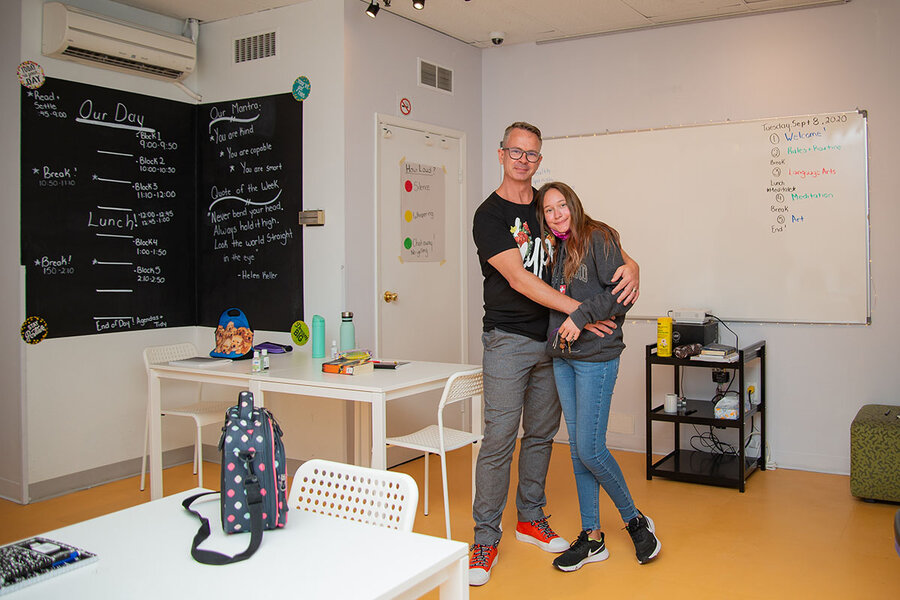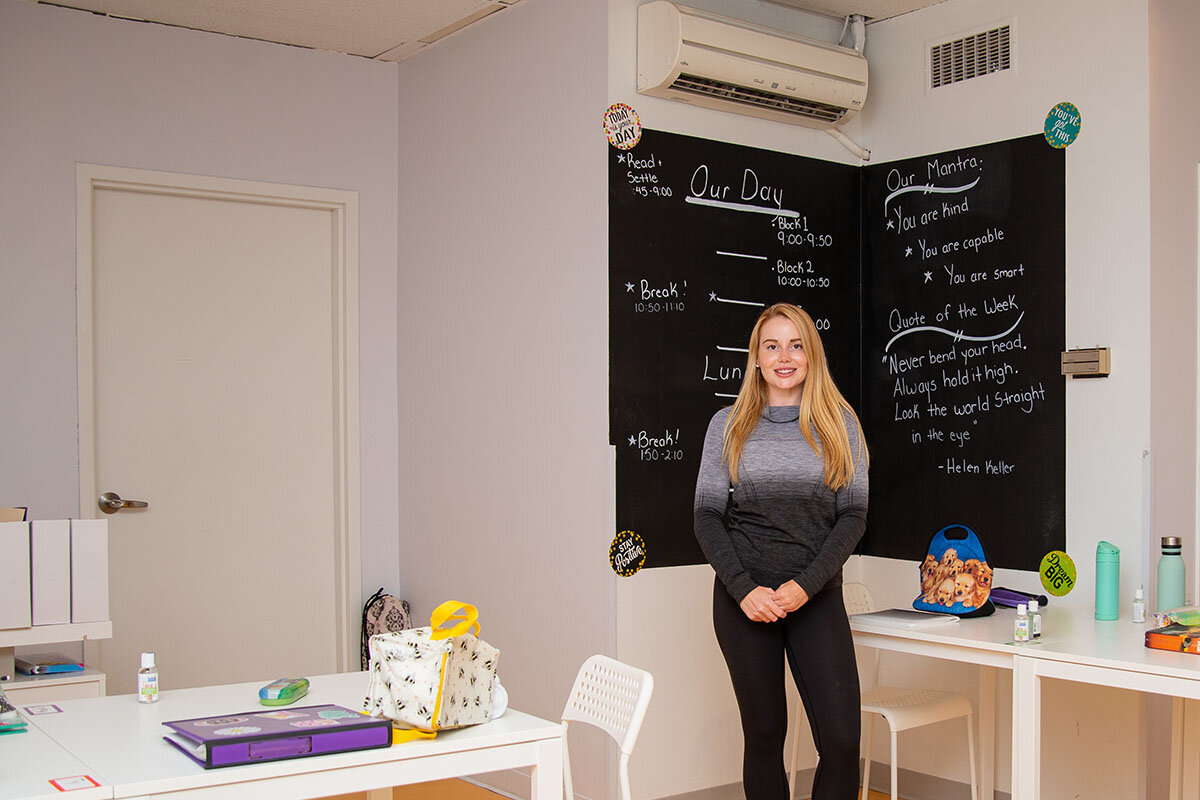Learning pods, low-income students, and the micro-schooling debate
Loading...
| Toronto
A month ago, Brad Thorpe had never heard of a learning pod.
Within a week, the Toronto father was busy converting a spinning room at a gym he owns into a classroom for his sixth grade daughter and seven classmates.
The entrepreneur who holds 15 patents describes himself as a “solutions guy” who had a problem: Schools are opening across Ontario Sept. 15, but with 27 students per class in his daughter’s age range, he worried about the school’s ability to maintain social distancing. So he hired an Ontario-certified teacher, shaped a curriculum, and “in a day and on a dollar” created a website launching the Girls Only Academy.
Why We Wrote This
With an uncertain school year ahead, some parents are creating stability for their children by hiring teachers to work privately with students in learning pods. That’s a creative solution, but it’s not an option for everyone.
That kind of entrepreneurial spirit has undergirded the rise of a “micro-schooling” movement across North America, where parents are coupling with other families to offer an alternative to in-class schooling they feel is unsafe or remote learning that they feel is inadequate.
Across the United States and Canada, families are experimenting with alternative schooling arrangements. Parents are taking to Facebook to inquire about tuition models, insurance policies, and potential podmates for their children while tutors and teachers offer their services. Start-ups are offering new platforms, hoping to tap the emerging market built by parents who say they are hustling to do whatever they can for their children this academic year.
But Mr. Thorpe says he’s had every insult lodged at him from opportunistic to elitist. His favorite: “disaster capitalist.”
In fact, many parents, education experts, and community advocates worry that “pandemic pods” could have unintended consequences that further widen gaps in achievement between socioeconomic groups. The conversation has surfaced new thinking about those long-standing inequities – examining people’s own privileges and access – that have long persisted but may not have been as overtly apparent.
“These pods are highlighting the kind of advantages that some have over others that are less visible maybe when there’s not a pandemic occurring,” says Agata Soroko, a doctoral candidate and part-time professor in the faculty of education at the University of Ottawa. “We’re often told that we live in a meritocracy and every person has an equal opportunity to succeed,” she adds. “These pandemic pods are troubling this narrative and bringing into light the inequities that various communities face.”
On the northwest corner of Toronto – far from the neighborhood where Mr. Thorpe was assembling desks past midnight the other night – Anna-Kay Brown was doing her own organizing. Her community event would highlight inequities in housing, schooling, and public transport. She, like Mr. Thorpe, has struggled with what to do with her two school-age children, an elementary and middle schooler. Her neighborhood, Jane and Finch, is one of Toronto’s worst hit by COVID-19. Here schools are reducing sizes to 15 and 20 per classroom in her children’s age groups. But she doesn’t feel safe and still hasn’t decided what to do two weeks before classes are to resume.
Co-chair of the Jane and Finch Education Action Group, Ms. Brown doesn’t know a single parent forming a pod and while she doesn’t blame parents who want to, she worries about what will happen to public school funding if this becomes a long-term trend.
“The gap is widening,” she says. “I believe that collectively parents should be advocating for every school and every place that children live to be safe for back to school.”
These inequities have been deepening in her own community for years. Private tutors and expensive extracurriculars have long given the advantage to families of means. Those disparities have only grown when public education funding is eroded and programs like music or arts get cut. And they grew further during the pandemic when households with working parents couldn’t support children with remote learning; some didn’t even have the technology to get online.
Now pods represent a new advantage for some – and a challenge to the system. Some groups are supplementing remote learning from schools with additional support from a private teacher or tutor. Others are going as far as starting their own private schools. Mr. Thorpe found that registering as a private school was the only way to meet Ontario regulations and enroll enough learners to make the program financially viable.
Eloise Tan, research program director at People for Education in Toronto, says pitting parents against one another is counterproductive, even as she is wary of some of the implications for privatization.
“Of those families that are creating learning pods, which they are financing themselves and with other parents, it’s not just a school outside of the system. We’re creating a mini-economy for education,” Dr. Tan says. “We don’t know how much this is going to take off; we don’t really know where it’s going to end. … Where is the confidence in public education going to be for parents? Where will the government’s commitment to protecting and enhancing public education be if we don’t have that superstrong and diverse enrollment from different kinds of families? Where are we going to be at the end of this? We don’t know.”
The unknowns abound as “pandemic pods” gain force. One Facebook group, Learning Pods – Canada, formed just a few weeks ago, has already attracted more than 11,000 members. At a recent virtual “town hall,” members were breathlessly discussing insurance policies and pitfalls. They bristle at criticism that they are widening divides between haves and have-nots and brainstorm ways to keep costs down so that it’s an accessible movement.
One start-up based in Iran, Pods Match, says that in the first two days that it went online in late August, 200 people signed up to the free service, mostly from the U.S. and Canada. The group is planning to expand beyond matchmaking to include an option that allows pods to welcome families from lower socioeconomic brackets for free or a discount. “We are worried and completely aware of this situation,” says Iman Davoodian, who started the company.
A father in Toronto, who wants to remain anonymous because he works with clients in medicine and education, says he’s a proponent of public school and its equalizing aims. But he says that by not reducing class sizes to adhere to social distancing required by the rest of society the government is shifting the burden to parents. He’s looking for a pod for his middle school-age son because he is a widower at home with a full-time job. “There are no good choices,” he says.
Mr. Thorpe says he too was a proponent of public education but not the way it is currently operating. He hopes learning pods will force the education ministry to think better about how they spend, especially because Ontario funds students at more than $12,000 per year, slightly more than what his Girls Only Academy costs per student at full enrollment. “The naysayers say we’re dismantling public education ... that we’re having a negative effect on long-term equity,” he says. “I have no interest in that. But I’m happy to help offer solutions.”
Editor’s note: As a public service, all our pandemic coverage is free. No paywall.








